![9 Growth Initiatives for Successful Companies [With Examples] cover](https://blog-static.userpilot.com/blog/wp-content/uploads/2023/10/9-growth-initiatives-for-successful-companies_15155630566fb139f1b93ef174daaaeb_2000.jpg)
What are growth initiatives? How can you implement them in the SaaS context? What do successful companies do to drive growth?
These are the main questions that the article explores.
Let’s dive right in!
What’s your biggest challenge with your current growth initiatives?
How do you currently personalize the user journey?
How do you collect and act on user feedback to fuel your growth initiatives?
Unlock Your Growth Potential
Sustainable growth isn’t about guesswork; it’s about systematically improving the user experience inside your app. Userpilot helps you create personalized onboarding, announce features, and gather feedback—all without writing any code.
Try Userpilot Now
See Why 1,000+ Teams Choose Userpilot

Growth initiatives summary
- Growth initiatives are strategies aimed at expanding a company’s customer base, market share, revenue, or profitability.
- Market Development involves selling existing products to new markets.
- Market Penetration focuses on selling more existing products within the current market.
- Product Development aims to grow within the existing market by introducing new or enhanced products.
- Diversification is a strategy involving entry into unrelated markets or industries, often through new lines of business or partnerships.
- Product-led growth uses the product as the primary driver of customer acquisition and retention, with minimal reliance on traditional sales and marketing.
- Growth loops leverage product virality, encouraging existing users to promote the product and attract new customers.
- SaaS companies enhance customer acquisition and retention through personalized onboarding and in-app guidance.
- Prioritizing features can help you maximize growth because you can better satisfy customer needs or serve underserved markets.
- Collecting and acting on customer feedback improves satisfaction and customer loyalty, and helps you uncover growth opportunities.
- A detailed growth strategy for retaining customers may involve various tactics, including self-serve onboarding and support, referral programs, and informed feature development.
- To take full advantage of growth opportunities, use product analytics to inform product decisions.
- Iterate on your pricing strategy to make the product competitive while generating enough revenue to support its growth.
- Strategic partnerships with other companies allow SaaS businesses to access new markets, benefit from partners’ acquisition channels and brand awareness, and leverage their expertise.
- Calendly, Notion, ClearCalcs, Userpilot, and Zapier successfully implemented a range of growth strategies to expand their customer base and market share.
- To see how Userpilot helps SaaS companies grow, book the demo!
What are growth initiatives?
Growth initiatives are strategies and projects intended to increase a company’s customer base, market share, revenue, or profitability. Their ultimate goal is to enable business expansion.
These initiatives can take many forms, like introducing new products, expanding into new markets, or increasing investment in innovation to gain a technological edge over the competition or expand the product range.
What are the different types of business growth?
Companies are able to stimulate product and business growth in numerous ways.
The Ansoff Matrix, a popular business growth model, distinguishes 4 key growth strategies:
- Market development
- Market penetration
- Product development
- Diversification
The taxonomy takes two key growth drivers into account: introducing new products or entering new markets.
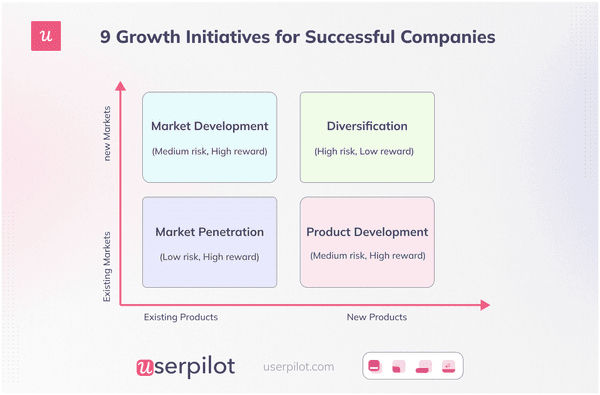
Market development
Market development, also known as market expansion, involves selling existing products or services to new markets. Its aim is to find untapped opportunities in new geographic regions or with different customer groups, which might have similar needs to the original target customer.
Businesses may do it by entering new countries, targeting new demographic groups, or adapting products to meet the needs of a different customer segment. That’s what Salesforce did when they launched their Nonprofit plan.
This strategy requires solid market research to develop a deep understanding of the new market’s dynamics, customer needs, and competitive landscape.
Market penetration
Market penetration is similar to a marketing growth strategy. It involves selling more of a business’s existing products or services to its current market. The goal is to increase market share within existing markets.
Companies try to achieve this through competitive pricing strategies, marketing, sales promotions, or by improving the product’s quality or customer service.
In other words, instead of entering a new market, market penetration is about maximizing the potential within the current market, which is a less risky strategy.
Product development
Product development focuses on growth in the existing market as well – by introducing new products or services or enhancing the existing ones.
Companies implement this strategy when they discover untapped opportunities for growth within the market.
Product development can involve innovation, upgrading existing products, or extending the product line.
Figma developing Figjam is a prime example of product development.
Diversification
Diversification is the riskiest growth strategy because it involves entering entirely new markets or industries that are unrelated to the company’s existing products, services, or customer base.
This can be achieved through mergers and acquisitions, developing new lines of business, or entering markets with no prior experience.
Adobe, known for creative software like Photoshop and Illustrator, diversified into the SaaS marketing space with the acquisition of Marketo. This diversification allowed Adobe to offer a broader suite of marketing solutions, catering to a different segment of the market compared to its creative software.
9 growth strategies to implement in your SaaS
Growth strategies like market penetration or development are the domain of senior management or business leaders. However, SaaS product managers have also a number of growth tools they can leverage to give the business a boost.
1. Embrace the product-led growth model
The product-led growth model is a scalable and sustainable growth strategy. That’s because it reduces organizations’ dependence on finite human resources necessary to market and sell the product and support customers in the traditional way.
How does it work?
In short, PLG uses products as the main driver of growth. Users explore the product through free trials or freemium, and in this way, experience its value, which is enough to convert them into paying customers.
It gets even better.
PLG depends on the self-service model. This means customers can access all the support they need on-demand and they don’t have to rely on customer success teams to hold their hand. That’s also how they purchase the product.
This reduces the customer acquisition and support costs dramatically.
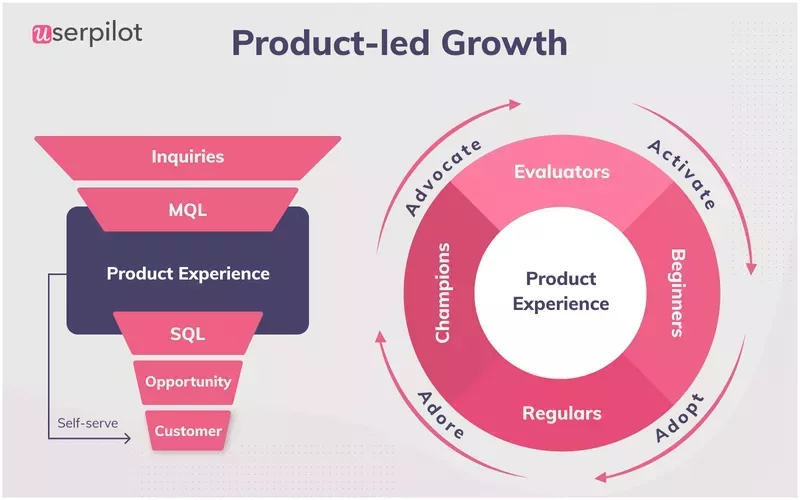
2. Create growth loops for acquiring new customers
Growth loops are a strategy that relies on embedded product virality to drive sustainable and compounding growth.
Basically, the existing customers promote the product and drive new customer acquisition by simply using it.
For example, by sending a Loom video, you not only communicate the intended message to your recipients but also allow them to experience the product value. Impressed by its intuitive design and ease of use, they may sign up for the product themselves.
How else can you create a growth loop?
Referral programs are an easy one. Creating communities, where users can share their designs and templates, requires a bit more effort. However, as the community grows, it becomes more attractive to new users.
3. Create personalized experiences for different segments
Personalization is the name of the game in SaaS at the moment.
Personalized sales and marketing efforts are more effective at driving customer acquisition because they showcase the aspects of the product that resonate with the specific user segment.
It doesn’t end there.
Once they sign up for the product, personalized onboarding can help users quickly learn how to use the key functionality to realize the product value.
As they get more competent, secondary onboarding helps them discover more complex features relevant to their use cases. At the same time, contextual in-app guidance helps them overcome the pain points that they face for a more satisfying experience.
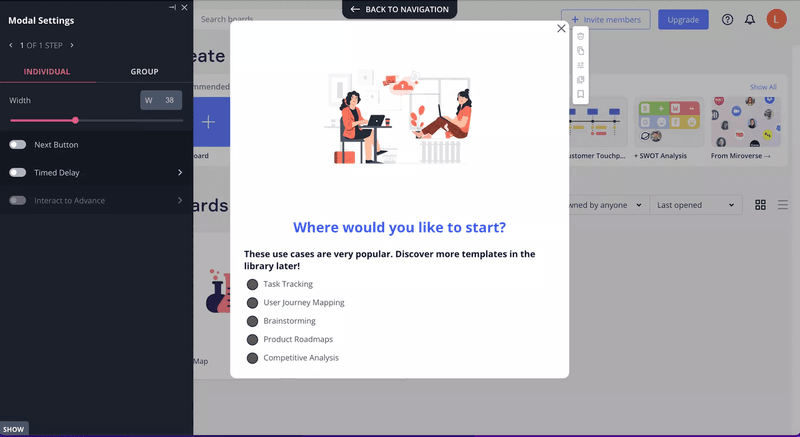
4. Prioritize features before product development
Prioritizing features according to your key criteria before product development is essential to maximize your growth potential.
For example, by prioritizing the features that are important to your most valuable customers, you can increase their loyalty and generate more revenue. Prioritizing features that cater to the underserved market segments, on the other hand, allows you to increase your market share.
Overall, effective prioritization can help you choose new growth initiatives with the best ROI.
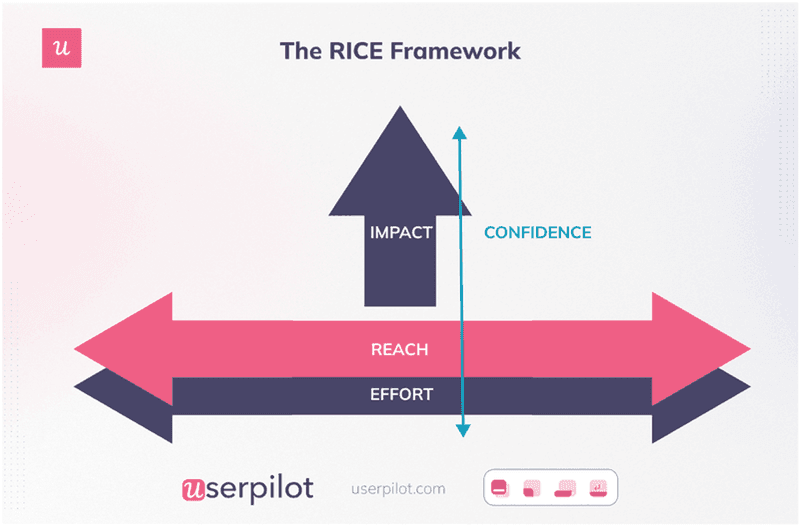
5. Collect and act on customer feedback continuously
Collecting user feedback religiously has a number of benefits.
First, it’s a chance to identify areas for improvement and ways to increase customer satisfaction. It also helps you stay in tune with their sentiment and keep a pulse on the shifts in the market. That’s how you discover new opportunities for growth.
There’s more.
By closing the feedback loop, you show your customers that their voice matters to you. This increases customer loyalty and helps you build stronger relationships.
The best part?
Collecting user feedback at scale is dead easy in-app. With a good feedback tool, all you have to do is choose a survey template, tweak it here and there, and trigger it for a specific user segment, either contextually or at a specific time.
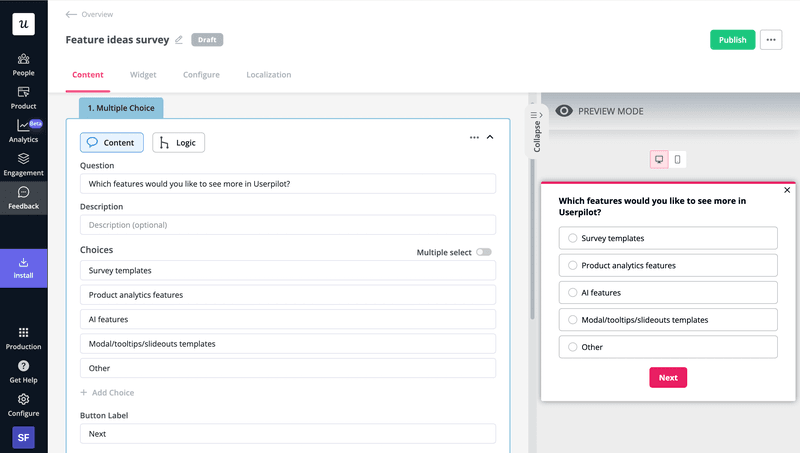
6. Develop a detailed growth strategy for retaining customers
Self-service support, personalized primary and secondary onboarding, referral and loyalty programs, developing the right features, and listening to user feedback are all tactics you can use to increase customer retention.
There are many more, the sky’s the limit, really.
The trick is to use these in an informed and structured way, reflecting the unique needs and characteristics of each user segment.
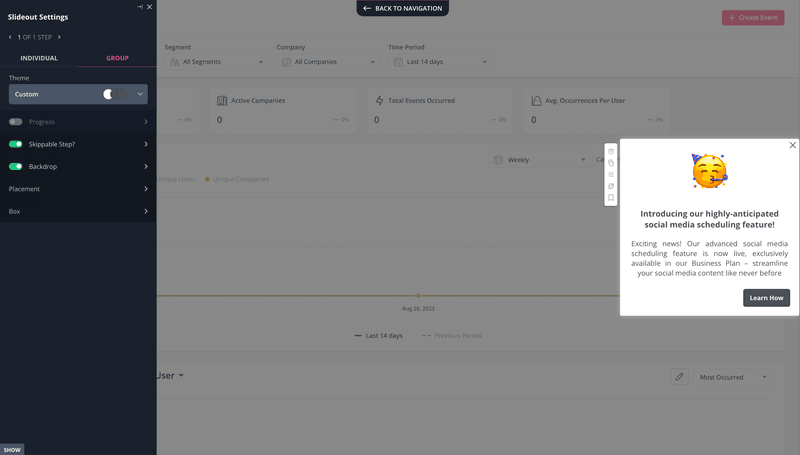
7. Base important decisions on data-driven insights
Modern analytics tools allow you to track all aspects of user behavior and extract actionable insights.
Don’t know why your users are dropping off? Do a funnel analysis and follow up with session recordings and interviews.
Not sure what the happy path for each segment is? Do a Paths analysis of your power users to identify the most optimal one.
Cannot decide which checklist design will be most effective? Run an A/B test.
Given how easy it is, there’s no justification for making key product decisions based on hunches and untested assumptions.
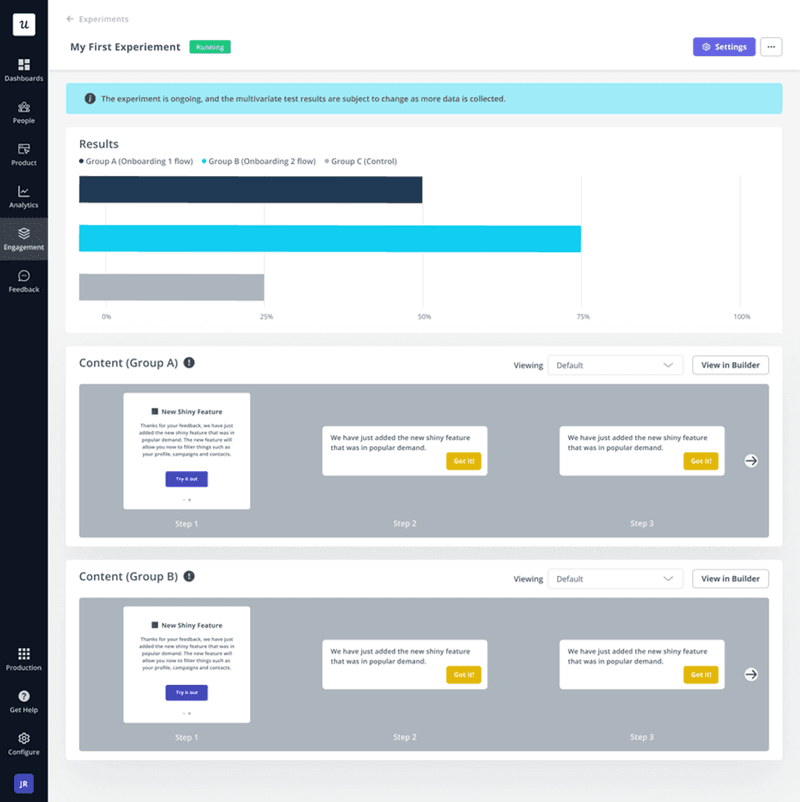
8. Iterate on your pricing strategy
Getting your pricing requires a lot of trial and error.
If the price is too high, you may struggle to attract enough customers. This could be an issue if you’re still developing the product and need lots of user data or if your product depends on network effects.
Lowering prices, on the other hand, may attract lots of unqualified leads that you won’t be able to support because of reduced revenue. And forget about funding further product development and new growth initiatives.
Apart from setting the price points, you also need to decide what features and usage limits to include in each plan. The aim is to give new users a chance to experience the ‘Aha!’ moment but not satisfy all their needs. Otherwise, they will never upgrade to higher ones.
9. Form strategic partnerships with other companies
Strategic partnerships with other companies are an effective growth strategy.
That’s because they allow you to benefit from their expertise or leverage their brand and distribution channels to reach new customers. It can also help you reduce the risk and share the costs.
This business growth strategy can take many forms, like reseller partnerships, joint ventures, mergers, or co-marketing.
For SaaS products, integrations with complementary solutions are often successful because they expand the product functionality and make it easier to embed into existing workflows.
Growth strategy examples from successful organizations
What strategies do SaaS companies use to facilitate growth, expand their reach and market share, and generate more income?
Let’s look at a few examples from market-leading SaaS products.
Calendly acquires customers through its viral loop
Calendly’s key selling point is that it helps you streamline the process of scheduling appointments by removing the back-and-forth messaging that it normally involves. You send a link to your calendar and your partner chooses a free slot that suits their schedule.
Here’s the kicker:
Whenever you send the link, you propel Calendly’s viral loop. That’s because the person who receives it experiences the product value first hand, even if they’re not the user themselves. And thanks to the ‘Powered by Calendly’ button, they can sign up and start using it in no time.
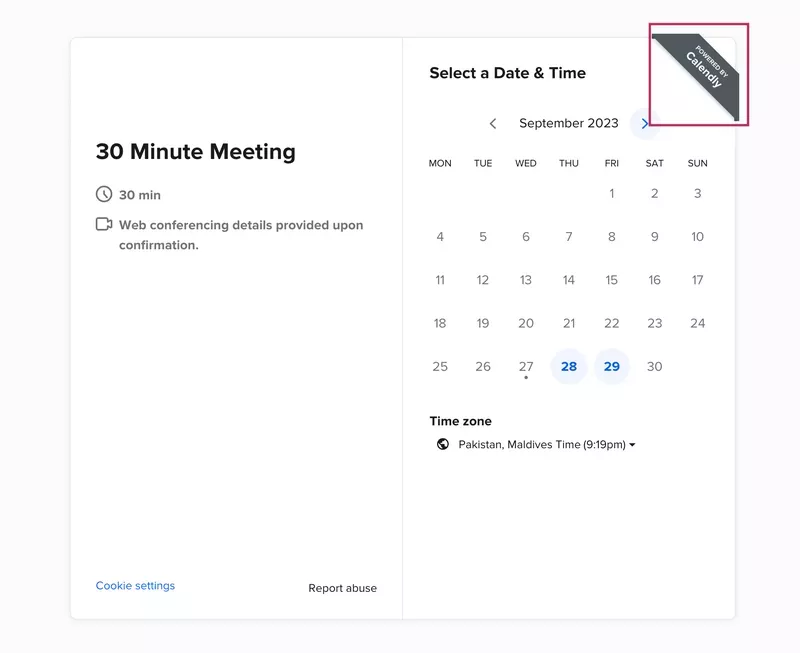
Notion’s business growth plan includes offering multiple price plans
Notion, the productivity and collaboration app, also uses product virality to drive growth. Users who adopt the product, share it in their networks, invite their team members, and drive customer acquisition. The company also has a vibrant ambassador program.
How else does Notion increase its user base and market share?
By offering various pricing plans catering to different user segments.
There’s a free plan for individual users and small groups, Plus for small professional teams, and Business for larger companies that want to improve collaboration and alignment between multiple teams. And of course, the Enterprise plan for the most complex features and custom usage limits.
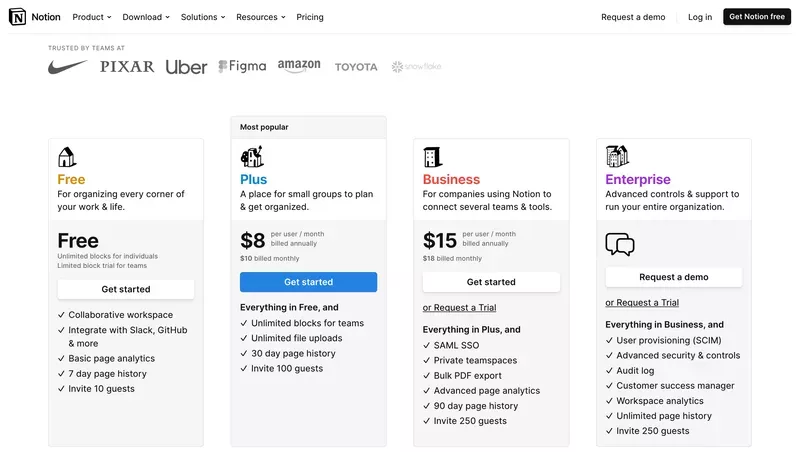
ClearCalcs offers a personalized in-app experience
ClearCalcs is a cloud-based software product that assists companies in the engineering sector in creating and verifying designs and computations.
As user activation is one of the primary revenue growth drivers, ClearCalcs prioritizes personalized onboarding.
The process starts with a welcome survey which collects the user data essential to customize their experience. Based on that, they personalize the dashboard for each user type to give them easy access to the calculations they need. These come with onboarding flows that help users learn how to use them.
How do they know if the flows are effective?
Userpilot helps them track user behavior and activation, and experiment on different flows.
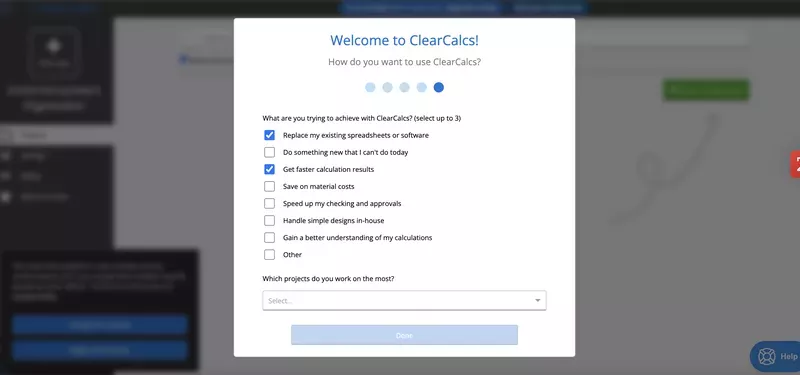
Userpilot retains customers by providing proactive customer support
Userpilot is a product growth platform, so we know a thing or two about growth initiatives.
As retaining customers is always easier and cheaper than acquiring them, that’s one of the things we prioritize.
Proactive customer support is one effective strategy we use. In practice, it means providing timely guidance and support so that users’ problems don’t spiral out of control and make them give up.
This is done through contextual in-app messages and easy access to help through the resource center.
What’s in there?
The onboarding checklist to kick things off as well as product documentation, video tutorials and webinars, case studies, and training resources. Users can also find there the feedback widget.
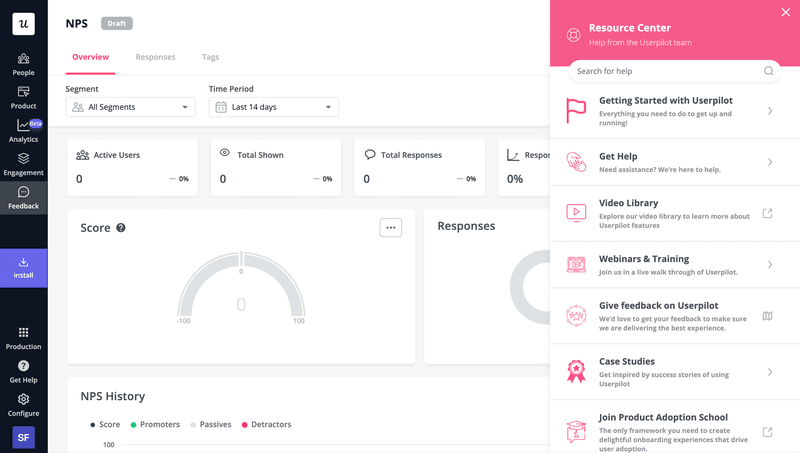
Zapier’s growth process involves offering numerous integrations
Zapier allows users to create custom integrations between different products without developer help. In this way, non-technical teams can easily send data from one app to another and automate their workflows.
Zapier’s marketplace contains over 1,000 integrations and new ones are added regularly. Companies want their app to integrate with Zapier because it drives their own growth.
Zapier benefits in two ways.
First, the increasing number of integrations increases its value to potential customers because they can integrate more tools.
Second, other companies drive Zapier’s customer acquisition through their own channels by offering integration.
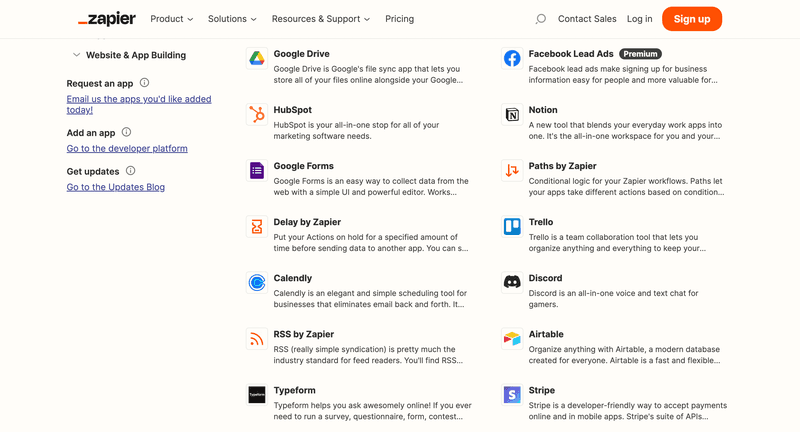
Conclusion
Growth initiatives come in different shapes and forms.
To increase their market share and generate revenue, SaaS companies can use such PLG strategies as product personalization, growth loops, or product virality.
If you want to see how Userpilot can help you boost your brand and product growth, book the demo!







